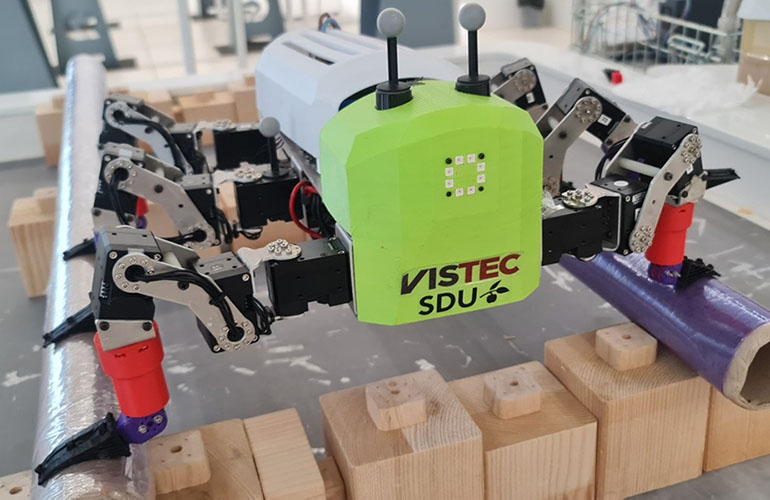|
Listen to this article  |

A hexapod robot with fin-ray inspired grippers that have altered crossbeams.
Many soft robotic grippers are inspired by the way a fish’s fin bends. They involve triangular components that bend inward, around an object to grip it. These components have transverse beams that sit at a 90° angle, which help the gripper to bend around an object.
These traditional grippers require a lot of force to pick up an object, and aren’t always capable of handling delicate objects without crushing them. Researchers from five different universities, led by Poramante Manoonpong from Syddansk University in Odense, are taking their inspiration from the way insects walk and grip things to develop a different way to make robotic grippers.
Instead of transverse beams sitting at a 90° angle, the international research team in Odense put the beams at 10° or 30° angles, similar to insect attachment pads. By changing the angle of these beams, researchers found that their grippers were able to bend more around objects and pick them up using 20% less force.
“We know that many animals are able to [grip or attach themselves] to surfaces using compliant pads or feet,” said Manoonpong. “We could see that the angle of insects’ attachment pads was different. Previous work has already investigated changing the angle of the gripper, but none have conducted detailed investigation on the effect of different crossbeam angles inside its frame.”
Using less force to pick up an object allows the gripper to handle more delicate items, like food items, without crushing them. When the researchers tested grippers with beams at 90° or 120°, it took much more force for the gripper to pick up an item.
The new grippers also improved the way that robots walk. When faced with uneven surfaces, like rocks, or round ones, like tubes to walk across, the robots were able to navigate the situation without complex control. The grippers resemble flippers, which can bend easily around the surface the robot walks across.
Inspired by nature
Manoonpong’s team of researchers were inspired by insect attachment pads, but they’re not the only researchers looking to nature to make advancements in robotics.
In December 2020, researchers at the University of Georgia College of Engineering developed a robotic gripper inspired by beanpoles. These soft grippers require only one pneumatic control, which simplified the operation. The gripper also had a fiber optic sensor in the robot’s elastic spine that can sense the item it’s picking up and any external disturbances.
In November 2020, researchers at UNSW Sydney created a gripper inspired by an elephant’s trunk. This soft fabric gripper was designed to handle heavy objects as well as fragile ones.
The Odense team tested their gripper model using only soft grippers. Their next challenge is to make one strong enough to handle harsher environments.
The Odense team’s entire research can be found here.
Credit: Source link


Comments are closed.